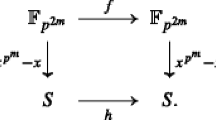Abstract
Permutation coding for multi-user communication schemes that originate from the Fast Frequency Hopping/Multiple Frequency Shift Keying modulation is investigated. Each sender is either passive or sends some signal formed as the concatenation of M elementary signals having M different specified frequencies. There is also a jammer, who can introduce disturbances. A single disturbance is either sending the signal that contains all M frequencies at a certain time instant or sending some elementary signal at all time instants. Each receiver receives a vector of M sets, where a set at each time instant contains a fixed frequency if and only if the corresponding elementary signal was sent by either some sender or the jammer. The task of the receiver is to uniquely decode the message of his sender. We present regular constructions of permutation codes for this scheme given the following parameters: the number of frequencies, number of pairs (sender, receiver), number of messages per sender, and maximum number of disturbances of the jammer.
Similar content being viewed by others
REFERENCES
Chang, S. and Wolf, J.K., On the T-User M-Frequency Noiseless Multiple Access Channel with and without Intensity Information, IEEE Trans. Inf. Theory, 1981, vol. 27, no. 1, pp. 41–48.
Cohen, A.R., Heller, J.A., and Viterbi, A.J., A New Coding Technique for Asynchronous Multiple Access Communication, IEEE Trans. Commun., 1971, vol. 19, no. 5, Part 2, pp. 849–855.
Han Vinck, A.J. and Haering, J., Coding and Modulation for Power-Line Communication, Proc. 4th Sympos. on Power-Line Communication and Its Applications, Limerick, Ireland, 2000, pp. 265–271.
Blake, I.F., Permutation Codes for Discrete Channels, IEEE Trans. Inf. Theory, 1974, vol. 20, no. 1, pp. 138–140.
Balakirsky, V.B. and Han Vinck, A.J., Constructions of Permutation Codes for Multi-User Communication, Proc. 2001 IEEE Information Theory Workshop, Cairns, Australia, 2001, pp. 79–81.
Balakirsky, V.B. and Han Vinck, A.J., On the Performance of Permutation Codes for Multi-User Communication, Proc. 2002 IEEE Information Theory Symposium, Lousanne, Switzerland, 2002, p. 307.
Author information
Authors and Affiliations
Rights and permissions
About this article
Cite this article
Balakirsky, V.B., Vinck, H. On the Performance of Permutation Codes for Multi-User Communication. Problems of Information Transmission 39, 239–254 (2003). https://doi.org/10.1023/A:1026110514701
Issue Date:
DOI: https://doi.org/10.1023/A:1026110514701



